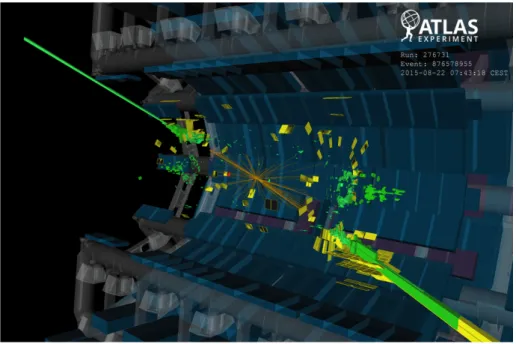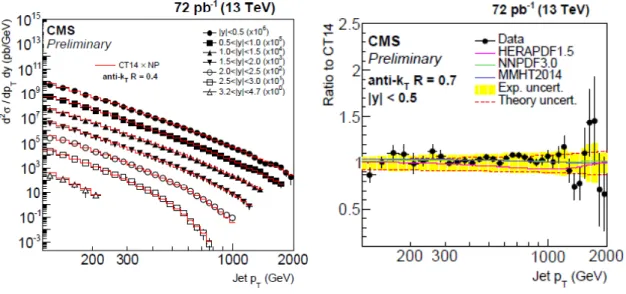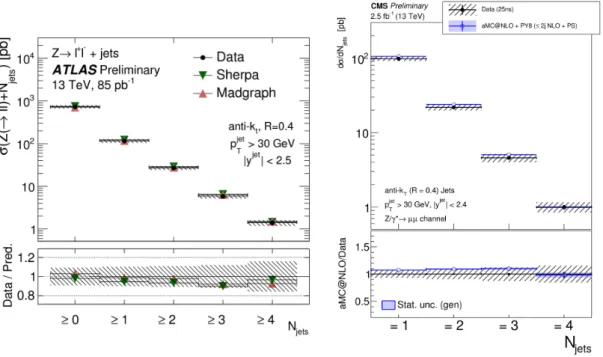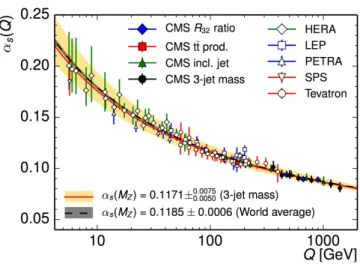A TL-PHYS-PROC-2016-114 26/08/2016
and New Physics
Siegfried Bethke ∗†
Max-Planck-Institute of Physics, Munich E-mail: bethke@mpp.mpg.de
Measurements on global properties and precision results on fundamental parameters related to the Strong Interaction sector of the Standard Model of particle physics, and searches for new phe- nomena beyond the Standard Model, performed by the two large multi-purpose particle detectors at the Large Hadron Collider (LHC), are summarised in this review. Special attention is payed to the new data obtained at √
s = 13 TeV in 2015, which offer a first glimpse at the large physics potential offered by the high-energy running of the LHC.
54th International Winter Meeting on Nuclear Physics 25-29 January 2016
Bormio, Italy
∗
Speaker.
†
On behalf of the ATLAS and CMS collaborations.
Results from ATLAS and CMS: Strong Interactions and New Physics Siegfried Bethke
1. Introduction and LHC Operation
The Large Hadron Collider (LHC) [1] is the world’s largest and most powerful particle accel- erator, located in a ring-shaped underground tunnel of 27 km circumference. Built and operated by the European Laboratory for particle physics, CERN, in the vicinity of Geneva, Switzerland, the LHC accelerates, stores and collides two beams of protons at c.m. energies ( √
s) of up to 13 TeV or - alternatively - beams of lead ions up to nucleon-nucleon c.m. energies, √
s NN , of 5.00 TeV (equivalent to √
s PbPb of 1.1 PeV). For short amounts of time and within regions of space-time limited by the quantum size of the colliding objects, these collisions create energy densities that closely resemble the conditions of the very early, hot and dense universe, at only 10 −10 to 10 −15 seconds after the Big Bang.
From 2009 to 2012, LHC provided integrated luminosities of about 5 fb −1 at √
s of 7 TeV, and of 25 fb −1 at √
s of 8 TeV. This period is commonly referred to as run-1. After the first long shutdown in 2013/2014 and more than 10 6 working hours spent for maintenance and the energy upgrade of LHC, proton collisions at √
s of 13 TeV were established in 2015, with an integrated luminosity of about 5 fb −1 for each of the two large multi-purpose detectors, ATLAS (Fig. 1) and CMS . This running period called run-2 is scheduled to commence until the end of 2018, reaching integrated luminosities of about 100 fb −1 at √
s of 13 and later 14 TeV. These data will provide a wealth of precision results on the Standard Model of Particle Physics (SM) and beyond (BSM), at the highest accessible collider energies.
In this presentation, I will focus on recent results from ATLAS and CMS on topics of the strong interaction, the part of the SM dominating most physics processes at LHC, and on searches for BSM physics. Wherever possible, first results from the most recent run-2 data at √
s = 13 TeV will be shown with preference. Topics related to electroweak interactions and symmetry breaking, and beyond, will be covered by P. Azzurri at this conference [3].
2. The ATLAS Detector
The ATLAS detector [4] is one of the two large multipurpose particle detectors 1 operated at the LHC. It was designed, built, and is being operated by an international collaboration of more than 3000 scientists from 178 institutes and 38 countries world-wide. With its length of 44 m, a diameter of 25 m and a weight of 7000 tons, ATLAS is one of the largest but rather light (in terms of weight/volume) particle detectors in the world. Symmetrically built around one of the proton beam collision points of LHC, ATLAS records the debris of the collision products of proton-proton and lead-lead collisions with highest precision, in order to reconstruct the dynamics and nature of the elementary collision reactions.
Within ATLAS, secondary particles, created by the collisions which leave the collision area and the LHC beampipe, are recorded by a number of different particle detector types. The ATLAS charged particle tracker, consisting of layers of silicon pixel and strip detectors plus outer shells of transition radiation detectors, allows to precisely measure the tracks of charged particles in a sur- rounding 2-Tesla solenoidal magnetic field, to determine the particle’s momenta and to reconstruct
1
The second multipurpose-detector, CMS [5] is described in more details in P. Azzurri’s presentation [3] at this
conference.
the location of their origin, namely one of the primary interactions of protons along the nominal beam direction, or possible secondary vertices from decays of heavy, short-lived objects like b- quarks. Electromagnetic and hadronic calorimeters around the tracker provide measurements of the energies of particles and particle jets, followed by a large muon spectrometer that detects and precisely measures the trajectories of muons in the outer magnetic field, generated by a system of large superconducting toroidal magnet coils.
The hermeticism of the ATLAS detector, both perpendicular as well as parallel to the LHC beam direction, allows to also reconstruct and detect particles which normally leave no trace in particle detectors, like neutrinos or new particles beyond the Standard Model (BSM). The gran- ularity and optimised resolution of the detector, consisting of more than 150 million electronic channels and a dedicated multi-step system of triggers and data reduction, allows to record all rel- evant particle reactions at 40 MHz collision rates without sizable losses caused by dead-times and processing times. The ATLAS readout and trigger system allows to filter and reduce the initial raw data flux of up to 10 16 bytes per second 2 (bps) to a finally recorded data rate of a few hundred collisions per second, or equivalently, up to one Gigabyte of data per second. These data are sent to the CERN Tier-0 computing centre, stored, calibrated and distributed to the world-wide LHC computing grid (WLCG), consisting of several 100 computing centres around the globe, for further processing, storage and physics analysis.
One of the highest mass di-jet events, measured and reconstruted by ATLAS at √
s = 13 TeV, is shown in Fig.2.
Figure 1: History of the integrated luminosity [2] (left) and structure of the ATLAS detector [4] operated at the Large Hadron Collider (right).
2
Design values of LHC operation are: 40 MHz collision rate of p-p bunches with 10
11protons per bunch, corre-
sponding to one collision every 25 ns, at a luminosity of 10
34cm
−2s
−1. A luminosity of 70% of the design value was
routinely achieved in the 2015 run. 40 MHz bunch crossing rate with a pile-up of typically 13 single p-p collisions per
bunch crossing generates a raw data flux of up to 10
16Bytes per second, which is equivalent to the transmission of 10
billion telephone calls at a given time.
Results from ATLAS and CMS: Strong Interactions and New Physics Siegfried Bethke
Figure 2: A high-mass di-jet event recorded at √
s = 13 TeV. The two high-p T jets have an invariant mass of 6.9 TeV and the leading and subleading jet have a p T of 1.3 and 1.2 TeV respectively.
3. Production Cross Sections at the LHC
At LHC energies, i.e. at collision energies around 10 TeV, the total cross section for proton- proton collisions is about 10 8 nb = 10 −25 cm 2 , which is totally dominated by the strong interaction between quarks and gluons, the basic constituents of hadronic matter. This corresponds, at LHC design luminosity, to 10 9 elementary collisions per second, which is about six orders of magnitude higher than the expected production rate of W and Z bosons, and nine orders of magnitude higher than Higgs boson production [6] or other objects with masses beyond 100 GeV/c 2 , see Fig. 3 (left).
While most of the "standard" strong interaction background is filtered away by the trigger system described above, dedicated searches for and studies of W and Z bosons, of Higgs bosons and signals for new BSM physics, are based on further selection criteria like the presence of energetic leptons (electrons or muons), photons, hadron jets, secondary decay vertices or missing transverse (w.r.t. the beampipe) energy. These, or subsets of these signatures, indicate the decay of vector bosons (Z and W), or other heavy objects like Higgs bosons, top-quarks or new BSM particles.
Such objects are then used to perform precision studies and determinations of the Standard Model and its fundmental parameters like masses and couplings, and to search for signatures for BSM physics.
The production cross sections for massive objects usually increase with increasing c.m. energy of the collider, see Fig. 3. The actual gain in cross sections at the highest LHC energy of 13 TeV, compared to the previous running at 8 TeV, is given in the right part of Fig.3. While the total hadronic cross section ("Min. bias" in Fig.3) only midly increases with √
s, the production cross
sections of SM particles like vector bosons, the Higgs boson and the top quark, increase by factors
of 2 to 4. Cross sections for new BSM particles like supersymmetric quarks and gluons, heavier
vector bosons and other objects, however, gain even more from the increased LHC energy of LHC Run-2, by factors around and exceeding 10. Note that already now, with the integrated luminosity available from the first year year of Run-2 data taking, some of the gains of cross sections already exceed the luminosity-weighted cross section which is marked, for CMS, by the vertical line.
Figure 3: Left: Production cross sections at Tevatron and at LHC [6]. Right: ratios of production cross sections at LHC c.m. energies of 13 and 8 TeV; the vertical line indicates the luminosity-weigthed cross sections for CMS at the end of 2015 data taking [7]
3.1 Inelastic p-p cross section
A measurement of the inelastic total proton-proton cross section was performed by ATLAS [8] at √
s = 13 TeV, using Minimum Bias Trigger Scintillators (MBTS) mounted in front of their forward calorimeter, resulting in σ inel. = 73.1 ±0.9(exp) ±6.6(lumi) ± 3.8(extrapol.) mb. A com- parison with previous measurements, at lower c.m. energies as well as one from cosmic rays at higher energies, is presented in the left part of Fig. 4. The data agree with the predictions by model calculations; a future measurement with higher precision may well differentiate between models.
3.2 Charged Particle Multiplicities and Correlations
Further studies of global properties of hadronic final states at LHC comprise the measure-
ments of charged particle multiplicities and their correlations. A measurement of the mean charged
particle multiplicity of inelastic p-p scattering events is shown in Fig. 5 (left), demonstrating that
the energy dependence of this basic quantity is well described by model calculations, inspired
by Quantum Chromodynamics (QCD) [9], but also by a simple parabolic fit in ln(s) [11]. The
right part of Fig.5 shows a measurement [12] of two-particle correlations in η − φ space within
high-multiplicity p-p events, where φ is the azimuthal angle around the beam pipe, and η is the
pseudo-rapidity, a measure of the angle w.r.t. the beam axis. These results confirm the presence of
Results from ATLAS and CMS: Strong Interactions and New Physics Siegfried Bethke
Figure 4: Inelastic p-p cross sections as function of the collider c.m. energy [8].
a ridge-like structure for same-side (∆φ= 0) pairs in high-multiplicity events at 13 TeV c.m. en- ergy, which is also seen by ATLAS [13]. One might speculate that this is an effect of color-strings connected between the hard scattered quark (or gluon) and the proton remnants of the collisions.
Figure 5: Mean charged particle multiplicities of inelastic proton-proton collisions as function of the col- lision c.m. energy [11] (left); two-particle correlations of charge particles within high multiplicity proton- proton collisions at √
s = 13 TeV [12] (right) demonstrating presence of the "ridge-effect", previously dis- covered in lead-lead-collisions, for same-side particle pairs (∆φ ≈ 0).
3.3 Inclusive Jet Cross Sections
The next level of specific properties of hadronic final states are measurements of inclusive
jet cross sections, which constrain the underlying parton desity functions (pdf) and are predicted
by perturbative QCD calculations. Fig.6 shows such cross sections, as a function of transvers jet momentum (p T ) and in different bins of pseudo-rapidity, measured by CMS using initial data from the 2015 run at √
s = 13 GeV [14]. Jets are defined using a specific jet definition (in this case, the anti-k t algorithm [15]) with a resolution parameter of R = 0.4. Similar as observed at lower c.m. energies, QCD predictions, based on a specific set of parton pdf’s, describe the data well, over many orders of magnitude of cross sections and in the p T -range of up to 2 TeV. The agreement using alternative sets of pdf’s is depicted in the right part of Fig.6.
Figure 6: Inclusive jet cross sections as a function of the jet transverse momenta, for different intervals of pseudorapity (left); ratio of data to the predictions obtained from the CT14 set of pdfs, compared to predictions of alternative pdf’s (right) [14].
3.4 Jet Multiplicities
Measurements of jet multiplicities constitute intrinsic tests of QCD, as the probability for each additional jet is proportional to the value of the strong coupling, α s . Even more importantly, multi- jet events are a dominant background for many studies of and searches for heavy objects, like top quarks or new heavy bosons, respectively. These backgrounds must be known and determined, with highest confidence, from data themselves.
An important background to many BSM searches and Higgs boson studies is the associate production of a Z boson together with n hadronic jets, where n = 0, 1, 2, ... . Measurements of cross sections of Z+jets final states at √
s = 13 TeV are displayed in Fig. 7, for anti-k t jets at R = 0.4 and n = 0 to 4 [16, 17]. The measurements closely resemble predictions made by QCD model calculations (comprising next-to-leading order perturbative QCD (NLO) plus parton shower Monte Carlo generators).
4. Determinations of α s
The strong coupling constant α s is one of the most important, fundamental parameters of the
SM of electroweak and strong interactions. Not being a physical observable itself, it is a quantity
Results from ATLAS and CMS: Strong Interactions and New Physics Siegfried Bethke
Figure 7: Associate production of jets and jet multiplicities in (Z → ` + ` − ) + jet events.
defined in the context of Quantum Chromodynamics (QCD) perturbation theory [9], which enters predictions for experimentally measurable observables. Measurements of such observables, in turn, are used to determine the numerical value of α s . More spefically, since α s is predicted - according to the concept of Asymptotic Freedom - to "run" with energy, values of α s (Q) are determined, where Q is relevant energy scale of data used in the determination 3 . The functional form of "running" is precisely predicted by the QCD β -function, such that each determination of α s (Q) can be converted to a value of α s (M Z ), at a common value of Q = M Z , namely the mass of the Z-boson.
Determinations of α s from hadron collider data, i.e. the Tevatron and the LHC, from the lepton-hadron collider HERA and the e + e − colliders LEP and PETRA are summarised in Fig. 8 [18]. All results from hadron colliders, except the one from tt production, and from HERA are derived in NLO QCD; results from tt production and LEP and PETRA are based on next-to-NLO (NNLO) QCD. Corresponding hadron collider results from ATLAS are also available [19] but are not reproduced in this figure; for a comprehensive summary of hadron collider results, see e.g. [9].
The LHC and Tevatron results can be combined and summarised as
α s (M Z ) = 0.1172 ± 0.0059 ,
using combination methods as applied for the determination of the current world-average of α s (M Z ) = 0.1181 ± 0.0011 [21]. The agreement with this world average, within errors, is excellent. Note, however, that the world average is determined from α s determinations which are complete to at
3
![Figure 1: History of the integrated luminosity [2] (left) and structure of the ATLAS detector [4] operated at the Large Hadron Collider (right).](https://thumb-eu.123doks.com/thumbv2/1library_info/4007587.1540970/3.892.141.762.653.874/figure-history-integrated-luminosity-structure-detector-operated-collider.webp)

![Figure 3: Left: Production cross sections at Tevatron and at LHC [6]. Right: ratios of production cross sections at LHC c.m](https://thumb-eu.123doks.com/thumbv2/1library_info/4007587.1540970/5.892.130.761.237.581/figure-production-sections-tevatron-right-ratios-production-sections.webp)
![Figure 4: Inelastic p-p cross sections as function of the collider c.m. energy [8].](https://thumb-eu.123doks.com/thumbv2/1library_info/4007587.1540970/6.892.257.622.147.411/figure-inelastic-p-cross-sections-function-collider-energy.webp)



![Figure 10: left: top-quark pair production cross sections at LHC energies [24]; right: single top-quark t-channel production cross sections in the Tevatron and LHC energy range [27].](https://thumb-eu.123doks.com/thumbv2/1library_info/4007587.1540970/10.892.132.753.696.910/figure-production-sections-energies-channel-production-sections-tevatron.webp)
![Figure 11: Summaries of direct measurements of the top-quark mass [29, 30].](https://thumb-eu.123doks.com/thumbv2/1library_info/4007587.1540970/11.892.136.757.588.893/figure-summaries-direct-measurements-quark-mass.webp)
![Figure 12: Summary of top-quark pole mass determinations [31].](https://thumb-eu.123doks.com/thumbv2/1library_info/4007587.1540970/12.892.244.664.149.462/figure-summary-quark-pole-mass-determinations.webp)